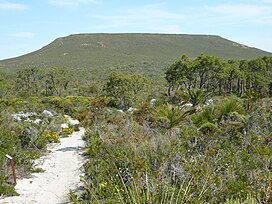Mount Lesueur
| Mount Lesueur | |
|---|---|
 | |
| Highest point | |
| Elevation | 313 m (1,027 ft)[1] |
| Coordinates | 30°10′31.8″S 115°11′56.7″E / 30.175500°S 115.199083°E |
| Geography | |
| Parent range | Gairdner Range |
Mount Lesueur is a near-circular, flat-topped mesa located 21 kilometres (13 mi) from Jurien Bay in Western Australia. It rises above the surrounding lateritic plain of Lesueur National Park which has eroded away around it.
Mount Lesueur was first sighted and named by Europeans as the French ship the Naturaliste sailed past Jurien Bay on its voyage up the Western Australian coast.[2] It was named in honour of Charles Alexander Lesueur, a natural history artist on board the ship. The next recorded sighting was by Captain George Grey, who led a small party through the area in 1839 after they were shipwrecked near Kalbarri.[2] In 1849 a party led by A.C. Gregory ascended Mount Lesueur.[2] They were followed the next year by botanical collector James Drummond on the first of his many visits to the area.[2]
A reserve (No.24275) was created around Mount Lesueur for "educational purposes" in the 1950s.[2] A more extensive area was gazetted as a national park in 1992.[2]
Mount Lesueur has an extremely high level of plant biodiversity, making it of immense research and conservation importance to botanists.
It has been identified with coal geology.[3]
References
- ^ "Mount Lesueur". Gazeteer of Australia. Geoscience Australia. Archived from the original on 5 June 2011. Retrieved 17 July 2009.
- ^ a b c d e f "Management Plan:Lesueur National Park and Coomallo Nature Reserve 1995 - 2005" (PDF). Department of Conservation and Land Management. 1995. Archived from the original (PDF) on 6 April 2011. Retrieved 17 July 2009.
- ^ Suwarna, Nana (1993), Petrology of Jurassic coal, Hill River area, Perth Basin, Western Australia, Curtin University, retrieved 10 October 2023

